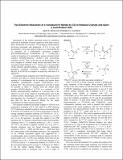Two-Electron Reduction of a Vanadium(V) Nitride by CO to Release Cyanate and Open a Coordination Site
Author(s)
Silvia, Jared Scott; Cummins, Christopher C.
DownloadmanuscriptR2.pdf (296.3Kb)
PUBLISHER_POLICY
Publisher Policy
Article is made available in accordance with the publisher's policy and may be subject to US copyright law. Please refer to the publisher's site for terms of use.
Terms of use
Metadata
Show full item recordAbstract
Generation of the nitrido functional group is commonly
achieved by treatment of metal complexes with azide sources
and is fostered by N2 extrusion.1 The analogous transformation
involving isocyanate and production of CO is less well
documented. A previous study by Fickes et al. showed that the
1e reduction of a niobium(IV) isocyanate complex
(OCN)Nb(N[t-Bu]Ar)3 (1-Nb(NCO), Ar = 3,5-Me2C6H3)
results in formation of a nucleophilic, anionic terminal nitride
complex [NNb(N[t-Bu]Ar)3]– (1-NbN–) with concomitant
evolution of CO.2 This, to the best of our knowledge, is the
only example of terminal metal nitride derivation from an
isocyanate ligand (Scheme 1A).2,3 Curious as to the generality
of this reductive decarbonylation, we sought to synthesize the
analogous vanadium isocyanate complex (OCN)V(N[t-
Bu]Ar)3 (1-V(NCO)) to compare its reactivity with that of 1-
Nb(NCO).
Date issued
2008-12Department
Massachusetts Institute of Technology. Department of ChemistryJournal
Journal of the American Chemical Society
Publisher
American Chemical Society
Citation
Silvia, Jared S., and Christopher C. Cummins. “Two-Electron Reduction of a Vanadium(V) Nitride by CO To Release Cyanate and Open a Coordination Site.” Journal of the American Chemical Society 131.2 (2009) : 446-447.
Version: Author's final manuscript
ISSN
1520-5126
0002-7863